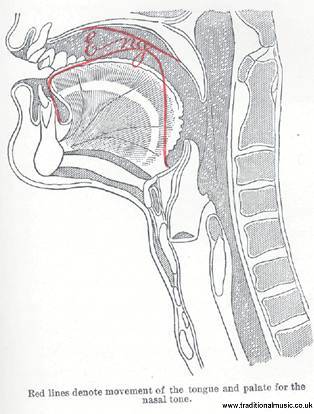| Share page | Visit Us On FB |
SECTION VI
THE ATTACK
To attack a tone, the breath must be
directed to a focal point on the palate, which
lies under the critical point for each differ-
ent tone; this must be done with a certain
decisiveness. There must, however, be no
pressure on this place; for the overtones
must be able to soar above, and sound with,
the tone. The palate has to furnish, besides,
the top cover against which the breath strikes,
also an extremely elastic floor for the breath
sounding above it against the hard palate
or in the nose.
This breath, by forming the overtones,
makes certain the connection with the reso-
nance of the head cavities.
In order to bring out the color of the
tone the whirling currents must vivify all
69
70 HOW TO SING
the vowel sounds that enter into it, and draw
them into their circles with an ever-increas-
ing, soaring tide of sound.
The duration of the tone must be assured
by the gentle but uninterrupted outpouring
of the breath behind it. Its strength must
be gained by the breath pressure and the
focal point on the palate, by the complete
utilization of the palatal resonance; without,
however, injuring the resonance of the head
cavities. (See plate, representing the attack.)
|
NASAL SINGING
By raising the back of the tongue toward
the soft palate and lowering the soft palate
toward the tongue, we produce nasal sound,
such as is heard in the pronunciation of the
word "hanger," .for instance. The air is
then expelled chiefly through the nose. The
nasal sound can be much exaggerated — some-
thing that very rarely happens; it can be
much neglected — something that very often
happens. Certain it is that it is not nearly
enough availed of. That is my own every-
day experience.
We Germans have only small opportunity
to make the acquaintance of the nasal sound;
we know it in only a few words: " En^el,"
"lan^e," "mangel," etc., — always where ng
occurs before or after a vowel.
73
74 HOW TO SING
The French, on the contrary, always sing
and speak nasally, with the pillar of the
fauces raised high, and not seldom exaggerate
it. On account of the rounding up of the
whole soft palate, which, through the power
of habit, is cultivated especially by the
French to an extraordinary degree, and which
affords the breath an enormous space as a
resonating surface to act upon, their voices
often sound tremendous. The tenor Silva
is a good example of this. Such voices have
only the one drawback of easily becoming
monotonous. At first the power of the organ
astonishes us; the next time we are disap-
pointed— the tone color remains always the
same. The tone often even degenerates into
a hollow quality.
On the other hand, voices that are not
sufficiently nasal sound clear and expression-
less. Madame Melba, for instance, whose
voice is cultivated to favor the head tones, and
sounds equally well in all its ranges, appar-
ently lowers the pillars of the fauces too
|
NASAL. NASAL SINGING 77
much, and has her chief resonance in the
head cavities; she cannot draw upon the
palatal resonance for single accents of ex-
pression. Consequently she loses in vocal
color. Thfe procedure, as soon as it becomes
a habit, results in monotony.
In the first case somewhat less, in the
second somewhat more, nasal resonance would
help to a greater variety of effect.
There are singers, too, who pursue the
middle path with consummate art. Thus
Madame Sembrich, in recent years, appears
to have devoted very special study to nasal
tones, whereby her voice, especially in the
middle register, has gained greatly in warmth.
To fix the pupil's attention on the nasal
tone and the elasticity of the palate, he
should often be given exercises with French
words.

